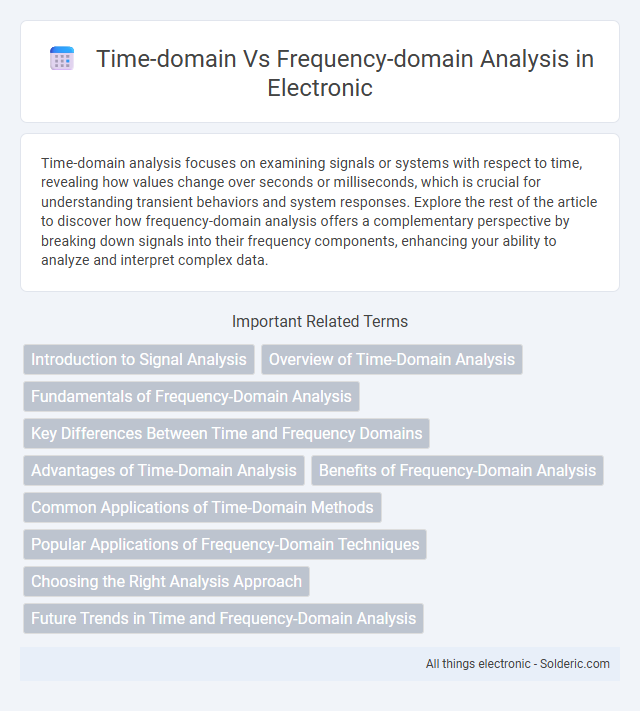Time-domain analysis focuses on examining signals or systems with respect to time, revealing how values change over seconds or milliseconds, which is crucial for understanding transient behaviors and system responses. Explore the rest of the article to discover how frequency-domain analysis offers a complementary perspective by breaking down signals into their frequency components, enhancing your ability to analyze and interpret complex data.
Comparison Table
| Aspect | Time-Domain Analysis | Frequency-Domain Analysis |
|---|---|---|
| Definition | Examines signals or systems with respect to time. | Analyzes signals or systems based on frequency components. |
| Primary Tool | Time waveforms, plots, and time response. | Fourier Transform, Power Spectral Density (PSD). |
| Data Representation | Amplitude vs. Time. | Amplitude/Power vs. Frequency. |
| Use Cases | Transient response, signal timing, time delay analysis. | Frequency content, harmonic distortion, bandwidth evaluation. |
| Information Details | Shows signal changes over time. | Identifies dominant frequencies and spectral characteristics. |
| Applications | Control systems, time-based signal processing. | Communication systems, audio signal processing. |
| Advantages | Direct observation of time events; intuitive interpretation. | Efficient frequency analysis; noise filtering. |
| Limitations | Harder to isolate frequency components. | Less precise time localization of events. |
Introduction to Signal Analysis
Time-domain analysis represents signals as they vary over time, capturing amplitude changes and transient behaviors critical for understanding real-time system responses. Frequency-domain analysis decomposes signals into their constituent frequencies using Fourier Transform techniques, revealing periodic components and spectral characteristics essential for filtering and modulation tasks. Your choice between these methods depends on whether temporal dynamics or frequency content better address the specific requirements of signal processing applications.
Overview of Time-Domain Analysis
Time-domain analysis examines how signals change over time, capturing amplitude variations and transient behaviors directly. It is essential for understanding system responses to varying inputs, including rise time, settling time, and time delays. This approach is particularly useful in time-sensitive applications such as control systems, signal processing, and fault detection.
Fundamentals of Frequency-Domain Analysis
Frequency-domain analysis transforms time-based signals into their constituent frequencies using tools like the Fourier Transform, enabling insight into amplitude and phase components across various frequency bands. This approach simplifies the identification of periodicities, resonances, and signal distortions that may be less apparent in raw time-domain data. Your ability to analyze systems or signals in the frequency domain is crucial for applications such as communications, control systems, and audio processing.
Key Differences Between Time and Frequency Domains
Time-domain analysis examines signals with respect to time, capturing how amplitude varies instantaneously, while frequency-domain analysis represents signals as a combination of sinusoidal components, revealing their spectral content. The key differences lie in the representation: time-domain shows signal behavior over time, and frequency-domain highlights the signal's frequency components and their magnitudes. Understanding these differences enables you to select the appropriate analysis method for applications like signal processing, communications, or vibration analysis.
Advantages of Time-Domain Analysis
Time-domain analysis offers direct observation of signal variations over time, facilitating intuitive interpretation of transient behaviors and system responses. It enables straightforward detection of time-varying characteristics like amplitude modulation, signal delays, and waveform distortions without requiring complex transformations. This approach is especially advantageous in real-time monitoring and control systems where immediate temporal information is crucial.
Benefits of Frequency-Domain Analysis
Frequency-domain analysis provides clear insights into the spectral content of signals, making it easier to identify dominant frequencies and harmonic distortion compared to time-domain analysis. This approach simplifies the design and optimization of filters, communication systems, and control systems by isolating frequency components and allowing precise manipulation. Complex behaviors such as resonance and system stability can be effectively analyzed using frequency response techniques, facilitating improved performance and diagnosis.
Common Applications of Time-Domain Methods
Time-domain analysis is widely applied in signal processing to assess transient responses and system behaviors over time, making it ideal for crash test analysis and vibration monitoring. It enables You to examine the amplitude and duration of a signal, which is crucial for diagnosing faults in electrical circuits and mechanical systems. Common applications include analyzing seismic activity, biomedical signals like ECG, and real-time control systems where temporal changes are critical.
Popular Applications of Frequency-Domain Techniques
Frequency-domain techniques are popular in signal processing applications such as audio analysis, telecommunications, and vibration analysis, where understanding the spectral content of signals is crucial. These methods enable the identification of frequency components, noise filtering, and system behavior characterization, which are essential for designing and optimizing your electronic and mechanical systems. Engineers frequently use Fourier transforms and spectral analysis to detect patterns and diagnose issues that are not apparent in time-domain data.
Choosing the Right Analysis Approach
Time-domain analysis provides detailed insights into signal behavior over time, making it ideal for transient or non-stationary signals, while frequency-domain analysis excels at identifying spectral components and periodicities within signals. Selecting the right approach depends on the specific application requirements, such as detecting time-varying features or understanding harmonic content. Engineers often combine both methods to achieve comprehensive signal characterization and enhance diagnostic accuracy.
Future Trends in Time and Frequency-Domain Analysis
Future trends in time-domain and frequency-domain analysis emphasize integration with machine learning algorithms to enhance real-time signal processing and anomaly detection. Advances in hardware acceleration and edge computing are driving more efficient and scalable implementations of high-resolution spectral analysis and time-frequency representations. Emerging applications in 5G communications, IoT, and biomedical engineering are pushing the development of adaptive, hybrid analytical frameworks combining time and frequency-domain techniques for improved accuracy and robustness.
time-domain vs frequency-domain analysis Infographic

 solderic.com
solderic.com